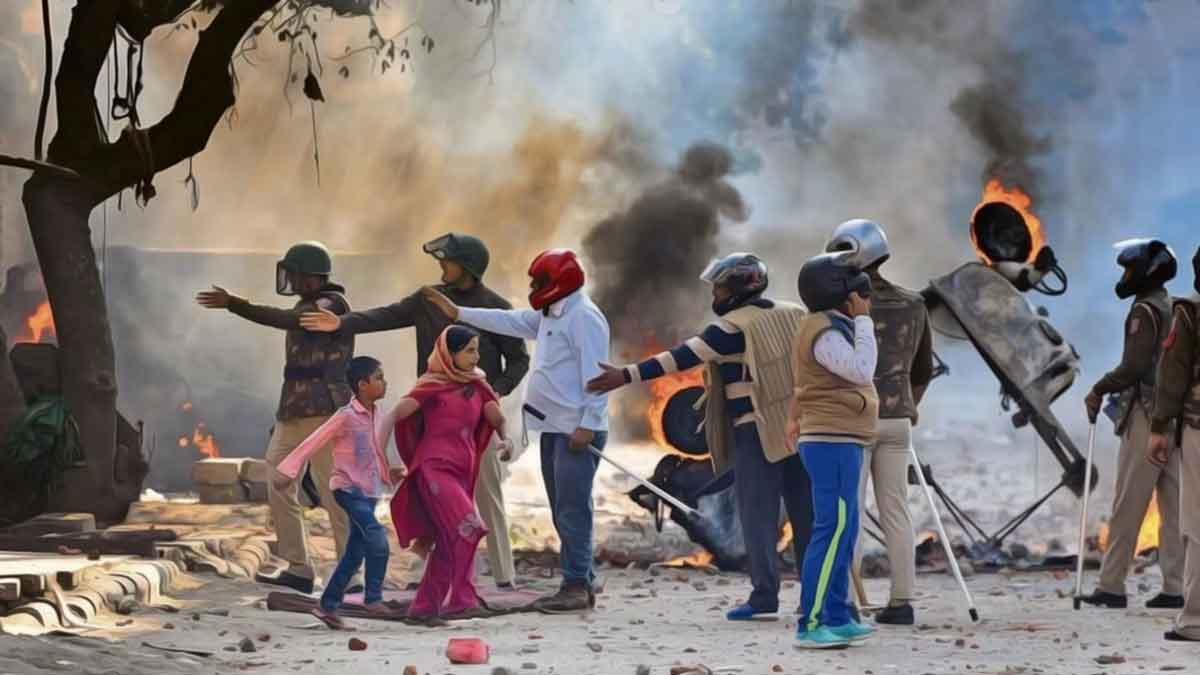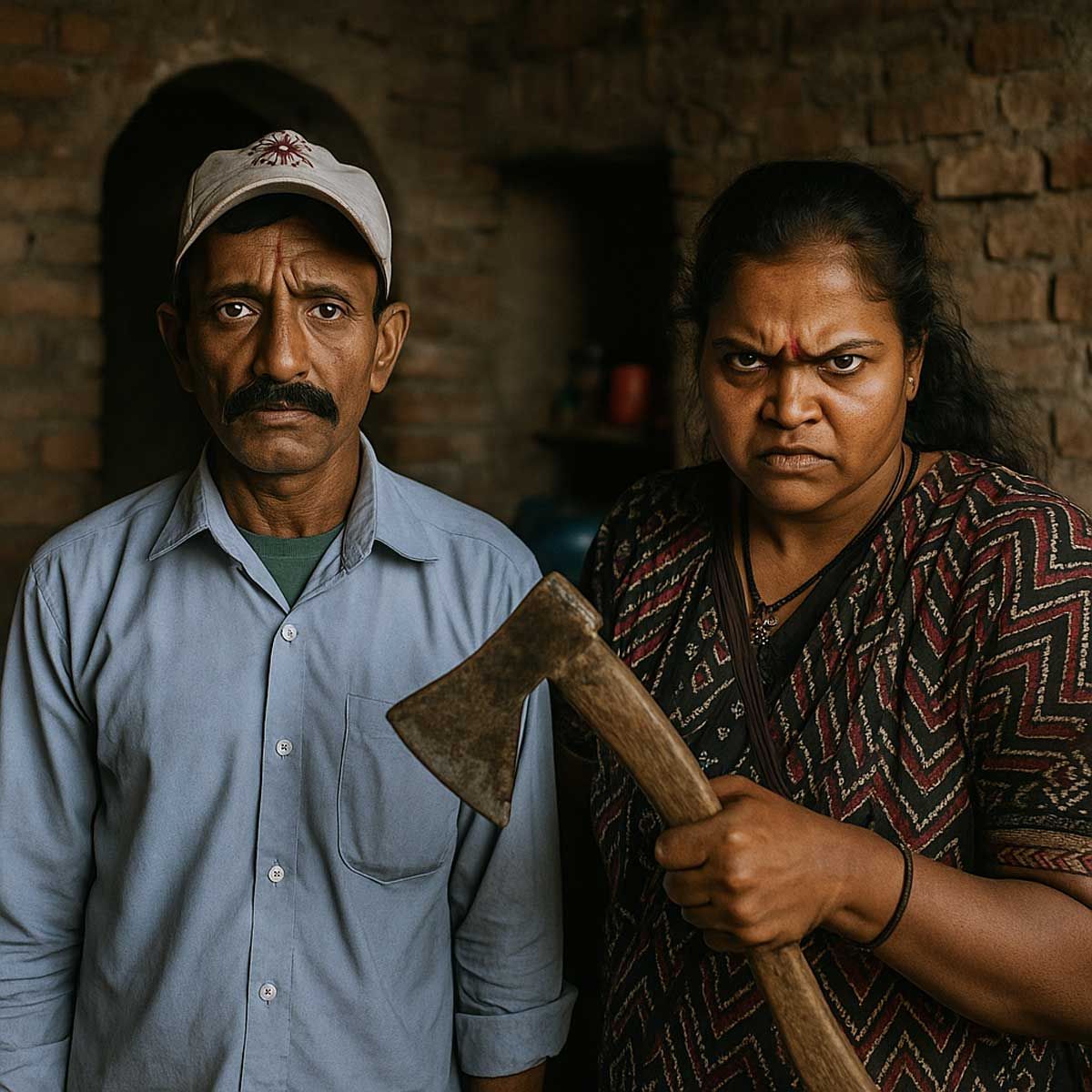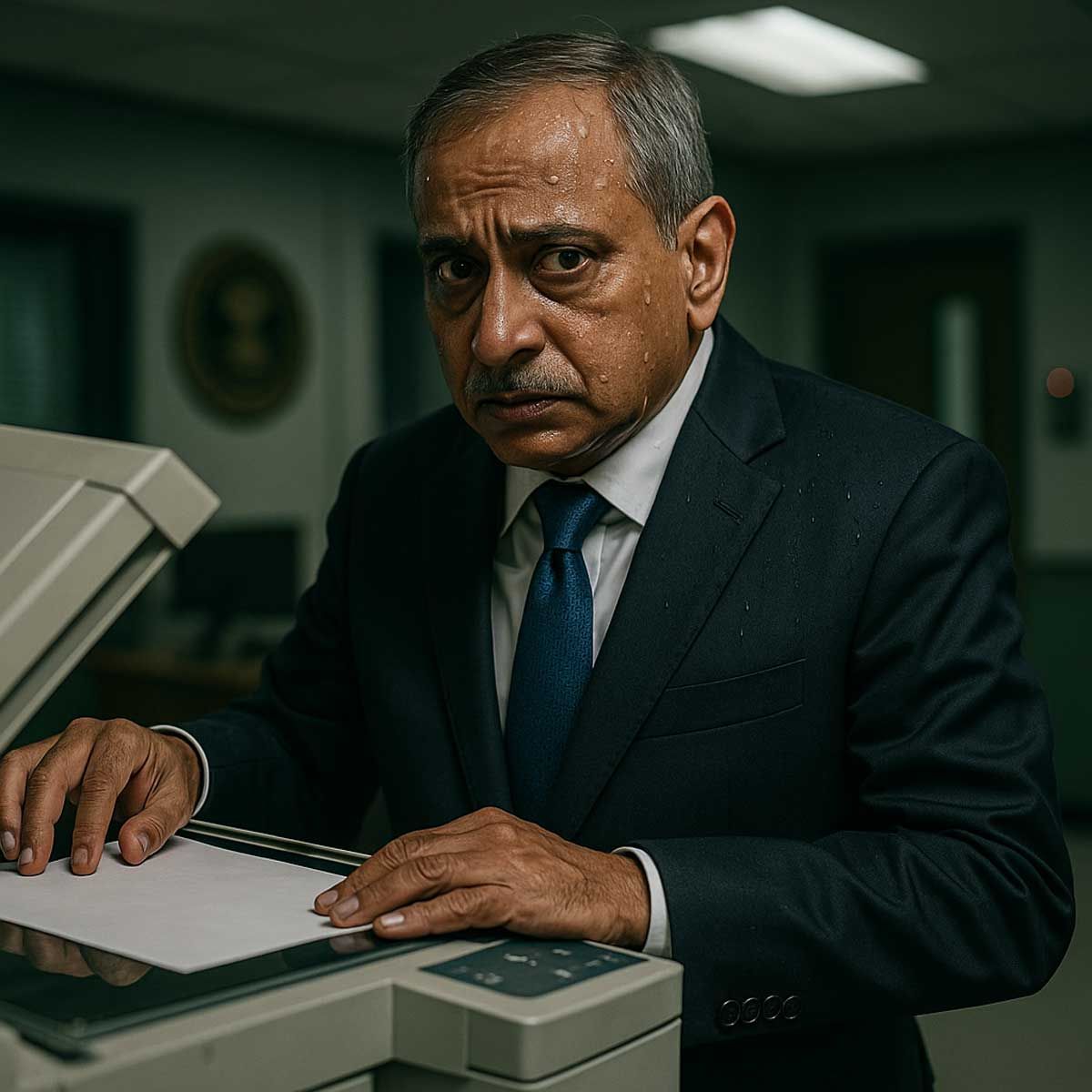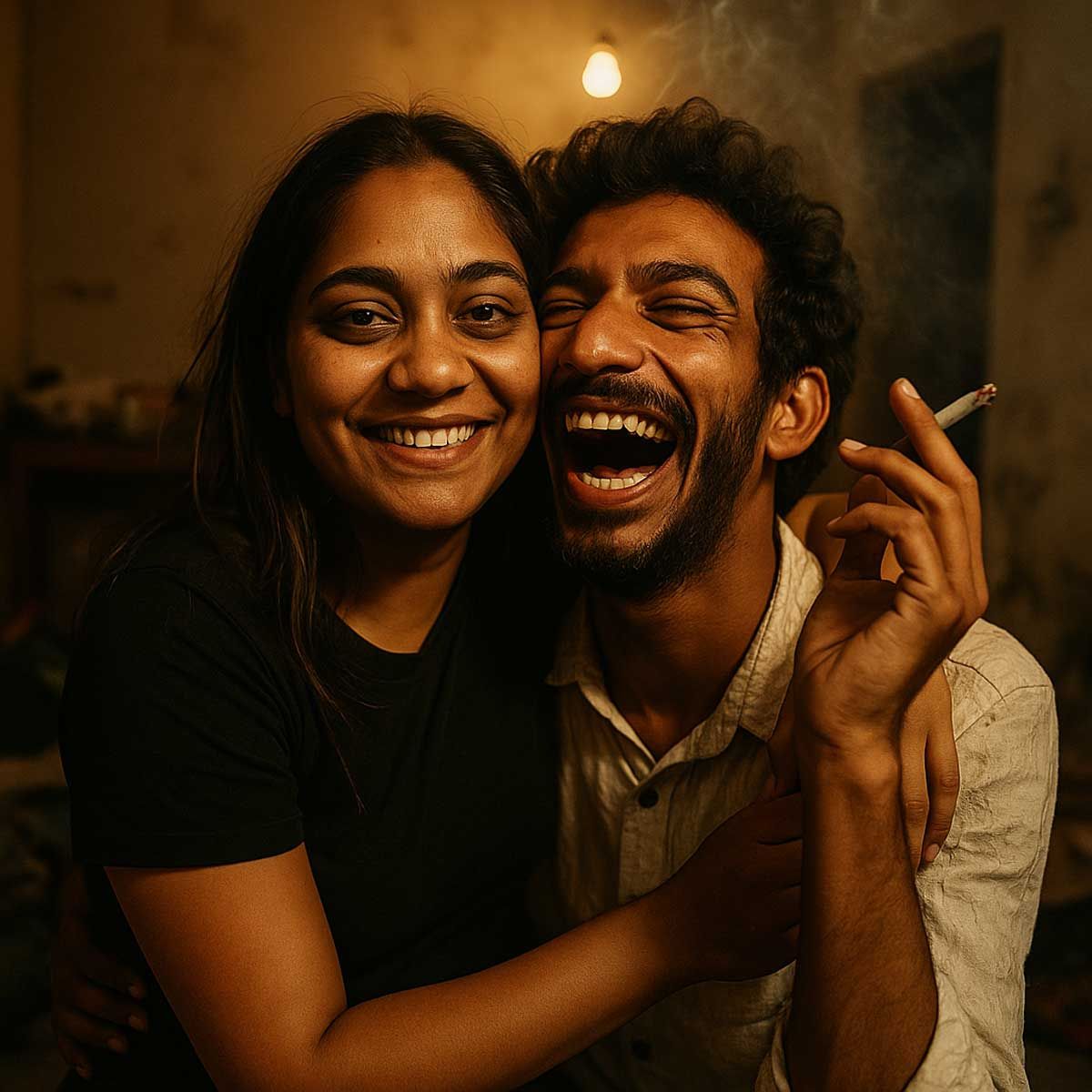More Coverage
Twitter Coverage
Satyaagrah
Written on
Satyaagrah
Written on
Satyaagrah
Written on
Satyaagrah
Written on
Satyaagrah
Written on
JOIN SATYAAGRAH SOCIAL MEDIA
Hindu man Sandeep Bhati, jailed during Delhi Riots, was acquitted as court found manipulated video by victim Shahrukh’s brother, IO lapses, no witnesses, and Rajdhani School’s role in Islamist mob attacks, including the brutal murder of Dilbar Negi

In a recent landmark judgment, Delhi's Karkardooma Court strongly criticized the Delhi Police for mishandling an investigation into the 2020 Delhi Riots. The court pointed out severe lapses, including the merging of six First Information Reports (FIRs) into one case, and rebuked the Investigating Officer (IO) for failing to conduct a thorough probe. The court uncovered that the primary evidence against a Hindu man, Sandeep Bhati, was a manipulated seven-second video that led to his wrongful implication.
On January 8, 2025, Additional Sessions Judge Pulastya Pramachala acquitted Sandeep Bhati and referred the case to the Commissioner of Police. The judge directed the Commissioner to evaluate the IO’s conduct and initiate appropriate action against him.
The allegations against Bhati stemmed from a case registered at the Karawal Nagar Police Station based on the statement of Shahrukh, a man injured during the riots on February 24, 2020. Shahrukh recounted that, at around 4:15 PM, he was traveling in an auto-rickshaw after visiting his maternal grandmother. When he reached Shiv Vihar Tiraha, a mob allegedly dragged him out of the vehicle, beat him with sticks and stones, and then shot him. He sustained gunshot wounds to his left leg and chest, eventually losing consciousness. According to his testimony, he regained consciousness in GTB Hospital.
Despite Shahrukh’s detailed account, the six FIRs involved in this case primarily reported incidents of loot and arson, but none of them named Bhati as a suspect. Furthermore, these complaints were filed by individuals who were not even present to witness the events or identify the perpetrators of the arson.
The prosecution highlighted that the IO prepared a site plan based on Shahrukh’s statement. The location of the alleged incident was marked as Shiv Vihar Tiraha on Main Road, Karawal Nagar, which connects Joharipur and Karawal Nagar Chowk via Shiv Vihar Tiraha. Notably, a Hanuman Temple stood beside the place of the incident, serving as a key reference point in the investigation.
|
While the investigation into the Delhi Riots case progressed, the police received eight additional written complaints from various individuals. These complaints were combined with the existing FIR for a consolidated investigation. However, one of the complainants, Arif Ahmad, later withdrew his complaint, explaining that his father had already lodged a similar report. Upon further review, it was revealed that the incident reported by another complainant, Mohammad Khalid, had occurred on 25th February 2020, which necessitated filing a separate investigation report. Consequently, only six remaining complaints—those from Mohammad Haneef, Sayba, Ashma, Gulab Singh, Mohammad Rahish, and Sahab Jadi—were retained for prosecution based on the proximity of date, time, and location to the original incident, according to the prosecution.
Among the complainants, Mohammad Haneef stated that he owned a paan shop near Hanuman Mandir at Shiv Vihar Tiraha. On 24th February 2020, he fled the area as the riots broke out. When he returned two days later, he discovered that his shop had been completely destroyed.
Another complainant, Sayba, recounted how her father, who operated a fruit cart (thela), had left it behind while fleeing with their family during the riots on the same day. When they returned to their home, they found the cart severely damaged. She mentioned that two days later, they sold the cart, unable to restore it to its former state.
Similarly, Ashma, a vegetable vendor, alleged that her family had evacuated their home during the riots on 24th February 2020. Upon returning much later, on 18th March 2020, she found that their house had been looted. She specifically noted the theft of Rs 20,000 in cash, gold jewelry, and 250 grams of silver jewelry.
In another instance, Gulab Singh described how he and his family had to abandon their house as the violence escalated on the same day. When they returned on 13th March 2020, they found that the lock on their gate was broken, as well as the lock of an iron box inside the house. Singh reported the loss of jewelry worth Rs 2 lakh and Rs 95,000 in cash.
Similarly, Mohammad Rahish stated that his family left the locality during the riots on 24th February 2020 and returned on 16th March 2020. He alleged that his motorcycle, a Passion Pro, which had been parked in a nearby plot, was damaged by rioters. He further added that the motorcycle was repaired two days later.
Amidst the chaos of the 2020 Delhi Riots, complainant Sahab Jadi shared a harrowing account of her ordeal. According to her statement, she and her family evacuated their home and moved to their ancestral village in Badaun on 24th February 2020. Upon returning to Delhi on 1st March 2020, she discovered her house had been ransacked. She alleged that cash amounting to Rs. 1,00,000, jewelry worth another Rs. 1,00,000, and other household articles had been stolen. She further noted that several items were damaged and burned during the violence.
A significant observation in the investigation revealed that all six complainants, including Sahab Jadi and their families, had vacated the riot-affected area on 24th February 2020. Notably, none of the complainants witnessed who damaged or looted their properties. Moreover, none of them named Sandeep Bhati in their complaints.
|
A Manipulated Video and the Arrest of Sandeep Bhati
The narrative took a critical turn during the investigation into the six FIRs. On 20th November 2020, Sameer Khan, the brother of injured victim Shahrukh, submitted a CD containing two video clips to the Investigating Officer (IO). Sameer claimed that the video showed his brother being dragged by a mob and identified Sandeep Bhati as one of the individuals in the clip. This evidence led to Bhati’s arrest on 23rd December 2020.
Following Bhati’s arrest, the police scrutinized his call data records (CDR). It was established that on the day of the incident, 24th February 2020, between 4:17:39 PM and 4:42:29 PM, Bhati’s mobile phone was located near Rajdhani Public School, A-1, Babu Nagar, Shiv Vihar, Delhi. The school was situated adjacent to Shiv Vihar Tiraha, the area where Shahrukh was reportedly found unconscious.
During his testimony, Sameer Khan identified two video files as crucial evidence. The first clip, lasting 7 seconds, allegedly showed Shahrukh being dragged by a mob, with Sameer identifying Bhati as one of the participants. The second clip, which was 15 seconds long, depicted an individual being dragged by another group of people, with Sameer claiming the victim was his brother Shahrukh.
As the investigation into the Delhi Riots case continued, additional sections of the Indian Penal Code (IPC) were added to the charges based on the statements of the complainants whose complaints were clubbed together. Sections 427, 436, 380, and 454 IPC were invoked to address the allegations of property damage, arson, theft, and criminal trespass. Furthermore, based on the supplementary statement of injured victim Shahrukh, Sections 392 and 394 IPC were added, as he reported that his iPhone 6 had been looted by the rioters.
On 24th March 2021, the police filed a charge sheet against Sandeep Bhati, listing a comprehensive array of charges under Sections 147, 148, 149, 188, 307, 380, 392, 394, 427, 436, and 454 IPC. Subsequently, charges were formally framed against Bhati, to which he pleaded not guilty and requested a trial.
The prosecution's case hinged primarily on a video clip, which they claimed depicted Bhati participating in the assault. Based on this evidence, Bhati was accused of attempting to murder Shahrukh and engaging in an unlawful assembly with the intent to cause widespread damage.
The charges explicitly stated:
“That in the evening of 24.02.2020, in the area at or around Shiv Vihar Tiraha, main Karawal Nagar, Delhi-110094, within the jurisdiction of PS Karawal Nagar, you being from a particular community along with your other associates (unidentified) formed an unlawful assembly, the object whereof was to cause maximum damage to the property and persons, including committing murder, commit criminal trespass, vandalism, robbery and arson in the shops, houses and other properties of the persons residing in the said area, damage their vehicles, use force, violence and firearms in prosecution of the common object of such assembly and thereby committed offences punishable under Section(s) 143/147/148 IPC read with Section 149 IPC and within my cognizance.”
The Investigating Officer further alleged:
“On the aforesaid date and place, between 4.00 PM to 6.00 PM, you [Sandeep Bhati] being member of said unlawful assembly in furtherance of your common object along with your other associates (unidentified) caused gunshot injuries upon the person of Shahrukh, S/o Shri Yakub Khan, aged about 25 years, merely on account of the fact that he belonged to the other community and with such intention knowledge that had his death been caused, you would have been guilty of murder and thereby committed an offence punishable under Section 307 IPC read with Section 149 IPC within my cognizance.”
Similar charges were also framed concerning the other complaints linked to this case, consolidating accusations of arson, robbery, and damage to property. The framing of these charges relied heavily on circumstantial evidence and a contested video clip, raising questions about the investigative process and the integrity of the evidence.
|
Sandeep Bhati’s Defence: Falsely Accused of Assault While Trying to Save Victim Shahrukh
In a dramatic turn of events, Sandeep Bhati, accused of assaulting Shahrukh during the 2020 Delhi Riots, firmly denied all charges against him. He contended that the allegations were baseless and that he had been falsely implicated in the case. Representing Bhati, his counsel Shailendra Singh highlighted significant gaps in the prosecution's evidence and investigative process.
Singh argued that the Investigating Officer (IO) failed to determine the exact location of the crime and could not verify the source of the video footage that led to Bhati's arrest. Furthermore, the IO relied on two photographs of Bhati for face recognition analysis but neglected to obtain the mandatory certificate under Section 65-B of the Indian Evidence Act, which is required to authenticate electronic evidence.
The defence also pointed out inconsistencies in the prosecution's video evidence. Singh emphasized that the video clip presented by the prosecution, which Sameer Khan claimed to have seen on television, was incomplete. The defence countered this by producing an extended version of the same video, which the IO later admitted was indeed longer than the one he had submitted.
In a pivotal argument, the defence referred to the testimony of prosecution witness number 07, Ct. Ravi, who stated that victim Shahrukh was lifted from Shiv Vihar. The extended video presented by the defence clearly showed that Sandeep Bhati was not armed and was, in fact, stopping others from assaulting Shahrukh. The defence acknowledged that Bhati could not take Shahrukh to the hospital or call the police due to the large gatherings and chaos at the scene.
Moreover, the defence highlighted that Bhati's visible aggression in the video was aimed at protecting Shahrukh rather than harming him. They asserted that the video clip provided by the prosecution failed to show Bhati assaulting the victim in any capacity.
The prosecution, on the other hand, relied on the fact that Bhati was present at the crime scene and was the only individual identified in the video. Based on this, they pursued the case against him. Despite presenting 21 witnesses during the trial, the prosecution's evidence did not conclusively establish Bhati’s involvement in the assault.
Rajdhani School: Epicenter of Islamist Mob Attacks on Hindus During the Delhi Riots
The Shiv Vihar Tiraha area, where incidents of assault, vandalism, and loot were reported as per the six FIRs, was located near Rajdhani School, owned by Faizal Farooqui. The area witnessed brutal violence during the 2020 Delhi Riots, with Islamist mobs reportedly targeting Hindus. On the afternoon of 24th February 2020, the body of Dilbar Negi was found in front of Anil Sweets, near Rajdhani School. In a gruesome act of violence, Negi’s hands and legs had been chopped off, and his body was set on fire.
Investigations later revealed that Rajdhani School had been turned into a base of operations by Islamist mobs. According to the Delhi Police chargesheet, the school was used as a strategic location to coordinate attacks on Hindus. The guard of the DRP School, located adjacent to Rajdhani School, provided critical testimony. He recounted that on the afternoon of 24th February, as he went to close the gates of DRP School, he saw a group of Muslims gathered at the gate of Rajdhani School. Among them was Faizal Farooqui, the school’s owner, who was reportedly sitting on his bike. Faizal instructed the guard of Rajdhani School, a Hindu, to allow access to “all his Muslim brothers” into the school premises. He is alleged to have said, “Aaj dekh lenge Hinduon ko” (Today, we will teach Hindus a lesson).
From the rooftop of Rajdhani School, one of the most sinister plans of the riots unfolded. The mobs allegedly used the vantage point to fire guns and hurl bottles filled with acid, stones, and other projectiles at Hindu residents. The first chargesheet filed in connection with the Delhi Riots specifically focused on the events at Rajdhani School during 24th and 25th February 2020.
The violence in the Shiv Vihar Tiraha area was relentless. On 24th February, the burned body of Dilbar Negi was recovered, and at 4:00 PM, Rahul Solanki suffered a gunshot injury. The following day, on 25th February, acid attacks targeted SSB Jawans, and by 4:30 PM, Veer Bhan sustained a gunshot wound to his head while crossing the Tiraha on his bike. By 5:00 PM, Dinesh also suffered a gunshot injury to his head while standing in the area. Later that evening, at 10:15 PM, Alok was injured by stones thrown by Muslim rioters.
The sequence of these brutal attacks enraged the local Hindu community, prompting a crowd to gather in the area. The events at Rajdhani School and the surrounding locality underscore the calculated nature of the violence, the use of strategic locations for attacks, and the deep communal tensions that defined the 2020 Delhi Riots.
The Delhi Karkardooma Court, in its judgment acquitting Sandeep Bhati, highlighted glaring deficiencies in the investigation conducted by the Investigating Officer (IO). The court acknowledged that while allegations of unlawful assembly and rioting, as stated by Shahrukh, were “well established,” the IO had improperly clubbed eight complaints with the present case and later decided to prosecute only six complaints alongside it. The court noted that this approach relied heavily on the assumption that the same mob might have been responsible for all incidents described in the six complaints, despite the absence of concrete evidence to substantiate this presumption.
The court made it clear that instead of individually investigating each of the six complaints, the IO had merely recorded statements under Section 161 of the Code of Criminal Procedure (CrPC) and prepared site plans for just three of the complaints. Notably, the IO’s acknowledgment of these site plans only occurred during cross-examination, where he admitted to his signature on the documents. Beyond these minimal steps, no further investigation was conducted into the six complaints.
Justice Pulastya Pramachala pointed out that the IO failed to confirm the dates and times of the incidents mentioned in the complaints or trace the source of the information on which the complainants based their reports. It was evident that all six complainants had left the riot-hit area on 24th February 2020 and had not witnessed the crimes or seen Sandeep Bhati engaged in any unlawful activities.
The court explicitly stated:
“Such stand of IO and prosecution, however, remained based on presumption that same mob would have been involved in those six incidents as well. Record shows that in the name of investigation on those six complaints, IO only recorded statement under Section 161 Cr.P.C. and prepared site plan for three complainants. IO even did not remember about preparing three site plans and it was only during cross examination by defence that IO admitted his signature on these three site plans. Apart from aforesaid steps, nothing more was done to investigate into other six complaints. IO even did not confirm as to when did these six incidents had actually taken place. It was well known to IO that none of these six complainants had seen their respective incident. Thus, they mentioned the date of incident in their respective complaints, only on the basis of some other source. IO did not bother to find out source of their information or any witness to such incidents, if taken place as reported by these six complainants.”
Further compounding the lapses, the court observed that the IO had failed to collect photographs or other physical evidence of the properties mentioned in the complaints of Ashma, Gulab Singh, and Sahab Jadi, despite this being a routine practice in similar cases.
Justice Pramachala remarked:
“Thus, it is well apparent, that IO literally shrugged off his duty to properly investigate all these complaints and to submit his report based on complete investigation. That is the reason that in the charges exact time of such incidents were not mentioned. There is no concrete evidence on the record of this case, except testimonies of these complainants, to establish the alleged incidents and reasons thereof.”
The court concluded that the failure to conduct a thorough investigation or to establish the exact time of incidents undermined the prosecution's case. This negligence, coupled with the lack of corroborative evidence beyond the complainants' testimonies, led to the court’s decision to acquit Sandeep Bhati.
In a scathing judgment, the Delhi Court called the Investigating Officer’s (IO) decision to club six unrelated complaints with the case against Sandeep Bhati as both “illegal and unprofessional.” The court noted that this action not only compromised the investigation into Bhati’s alleged role in the attack on Shahrukh but also caused “injustice to the six complainants” by failing to properly investigate their grievances.
The prosecution built its case against Bhati primarily on two videos, claiming these proved his involvement in the assault on Shahrukh. However, only one 7-second video identified Bhati. The defence countered this with a 12-second extended version of the same footage, which included both Bhati and Shahrukh but did not show Bhati engaging in any assault. On the contrary, Bhati was seen stopping others from attacking Shahrukh.
The court observed:
“But, video D-1 shows further part of video Ex.PW16/V-1 for another 5 seconds. In this video accused is seen stopping the others from assaulting the victim. Ld. prosecutor took an objection that this video was not forensically examined, hence cannot be looked into. However, that objection cannot be a reason not to compare this video with some photographs proved by prosecution itself as Ex.PW16/P-1 to P-13.”
The defence argued, and the court agreed, that the prosecution’s key evidence—18 photographs provided by Sameer (Shahrukh’s brother)—were screenshots from the omitted five seconds of the video. These screenshots showed individuals participating in the violence. The court noted that instead of identifying and prosecuting these actual culprits, the IO falsely implicated Sandeep Bhati.
The judgment stated:
“This goes on to show that PW16 and IO did have video D-1 with them. IO did not use that longer video, rather he cut short that video for 5 seconds, to omit the portion showing role of accused as stopping others from assaulting the victim. Photograph Ex.PW16/P-7 and P-8 showed the persons, who were part of assaulting group. But, IO instead of tracing and prosecuting those actual culprits, framed accused herein for assault on the victim.”
Further, the court pointed out that the IO made no effort to determine the source of the video, a critical lapse in a case where the video formed the primary evidence. The court found that the IO relied on video Ex.PW16/V-1, and apart from this, the prosecution presented no other evidence against Bhati.
In light of these findings, Justice Pulastya Pramachala concluded that the investigation was deeply flawed and biased, leading to the wrongful implication of Sandeep Bhati. The court acquitted Bhati of all charges and referred the IO’s conduct to the Commissioner of Police for review, recommending appropriate action against him. Furthermore, the court directed a separate investigation into the six complaints initially clubbed with the case and ordered a final report to be filed in each.
The Conviction and Dramatic Acquittal of Dinesh Yadav in the 2020 Delhi Riots Case
In May 2023, a Delhi court acquitted Dinesh Yadav alias Michael, Sandeep alias Mogli, and Tinku of charges related to rioting during the 2020 anti-Hindu Delhi Riots. The court found that there was insufficient evidence to convict the three, emphasizing that mere possibilities could not be treated as evidence. The trio had been accused of being part of a riotous mob that vandalized two properties and looted items, based on complaints filed by Aakil Saifi and Irfan. Following these complaints, FIR 124 was lodged at the Gokalpuri Police Station, and charges were framed against the accused under Sections 147, 148, 149, 380, 188, 427, and 436 of the Indian Penal Code (IPC).
Justice Pulastya Pramachala, while delivering the verdict, observed significant shortcomings in the prosecution’s case. Notably, the victims, who also served as witnesses, were not present at the location of the alleged incidents during the riots. This rendered their statements hearsay, as they relied on information received from others rather than direct observation. The court further pointed out that the special public prosecutor improperly influenced the witnesses during cross-examination, leading them to identify the accused without substantial evidence to support their claims.
It is essential to revisit that Dinesh Yadav had previously been convicted in January 2022, becoming the first person to be sentenced in the 2020 Delhi Riots case. He was sentenced to five years in jail on charges of setting fire to the house of a 73-year-old Muslim woman and allegedly stealing her buffalo and calf. The case was widely discussed at the time, as it symbolized the beginning of judicial outcomes in the Delhi Riots cases.
However, the conviction of Dinesh Yadav raised critical questions about bias in the judicial process. The court’s decision to convict him appeared to hinge heavily on his religious identity as a Hindu, highlighting inconsistencies in the interpretation and application of legal provisions. This was contrasted sharply with the case of Dilbar Negi, a Hindu man brutally murdered during the riots, where the accused individuals received bail under circumstances that raised concerns about fairness.
Justice Pulastya Pramachala’s eventual acquittal of Dinesh Yadav and others in the rioting case further emphasized the lack of robust evidence and the influence of external factors on the legal process. This case exemplifies the challenges in ensuring impartiality and thoroughness in investigations, especially in communal violence cases, where tensions and biases often complicate judicial proceedings.
 |
 Support Us
Support Us
Satyagraha was born from the heart of our land, with an undying aim to unveil the true essence of Bharat. It seeks to illuminate the hidden tales of our valiant freedom fighters and the rich chronicles that haven't yet sung their complete melody in the mainstream.
While platforms like NDTV and 'The Wire' effortlessly garner funds under the banner of safeguarding democracy, we at Satyagraha walk a different path. Our strength and resonance come from you. In this journey to weave a stronger Bharat, every little contribution amplifies our voice. Let's come together, contribute as you can, and champion the true spirit of our nation.
 |  |  |
| ICICI Bank of Satyaagrah | Razorpay Bank of Satyaagrah | PayPal Bank of Satyaagrah - For International Payments |
If all above doesn't work, then try the LINK below:
Please share the article on other platforms
DISCLAIMER: The author is solely responsible for the views expressed in this article. The author carries the responsibility for citing and/or licensing of images utilized within the text. The website also frequently uses non-commercial images for representational purposes only in line with the article. We are not responsible for the authenticity of such images. If some images have a copyright issue, we request the person/entity to contact us at This email address is being protected from spambots. You need JavaScript enabled to view it. and we will take the necessary actions to resolve the issue.
Related Articles
- 'Anti-Hindu Delhi riot was remotely supervised by Umar Khalid just like 9/11 conspirators,’ prosecutors oppose Khalid’s bail plea, says 'Riot key conspirators were like entertainers who resorted to damrubaazi to attract crowd'
- Charges framed against Tahir Hussain by Delhi Court for Delhi Anti-Hindu riots 2020: 5 accomplices, active participant, used own house for throwing stone, patrol bombs etc., elaborate preparations to target Hindus
- NDMC to bulldoze “illegal encroachments” in Delhi's Jahangirpuri where riots broke out against Hindu devotees: Tukde tukde gang supporter AAP’s Amanatulah Khan says ‘attempt to disrupt peace during Ramzan’
- Sleeper cell module was activated in pre-planned violence to establish dominance of Muslim community so Hindus don't dare to take out Shobha Yatras in future: Stones collected and kept on route of yatra ahead of time
- Erotic slurs, explicit images, and rape threats, how hostility towards Hindu women continues unflagging on social media
- Founder of 'The Wire' and 'The Print' had a melodramatic meltdown while objecting to meat ban during Navratri: How meat has been used as a political tool to hurt religious sentiments of Hindus during festivals
- Ex-radicalised Muslim author studies mosques in UK, reveals Taliban, ISIS-like lifestyle of the ultra-orthodox community
- Bulldozer out to teach a lesson to criminals, rioters who create unrest in the society: Razed off all the shops near the dargah in Khambhat where stone-pelting took place on the chariots in Rath Yatra procession, Gujarat
- In another incident of ‘Land Jihad' how property in Shiv Shakti society of Mora, Surat, came in possession of Waqf Board: Gandhinagar based trust claims that Board is illegally taking over properties by misusing the Waqf Act, 1995
- Mini-Ratna Pawan Hans helicopter service gives way to the controversy by recruiting ‘only Muslim’, similar to a list of all Muslim candidates selected by West Bengal Police in the year 2020: Here is how there could be a Jamia connection
- Why authorities ignoring conspiracy of Sexual objectification of Hindu women: #Hslut4Mstud Users on Reddit, Twitter and Tumblr are targeting Hindu women with pornographic content ‘for Muslim studs’
- ‘For the last 35 years, no girl was wearing hijab, they came with CFI lawyer, insisted on wearing hijab in class and were very aggressive’: Udupi College principal Rudre Gowda
- Online Syndicate of radical Islamists that was targeting people for demanding justice for the slain Hindu Youth is exposed by Social Media user: Kishan Bharwad murder case
- Islamists, journalists and ‘liberal-secular’ intellectuals indulge in making ‘Hinduphobic’ remarks and mocking Hindu deities in an attempt to discredit the discovery of Shivling inside Gyanvapi masjid in Varanasi
- Manyavar commercial featuring Alia Bhatt vilifies Hindu wedding ritual Kanyadaan: Why not object Western practice of ‘giving away the bride’ and Nikah (marriage contract)




























